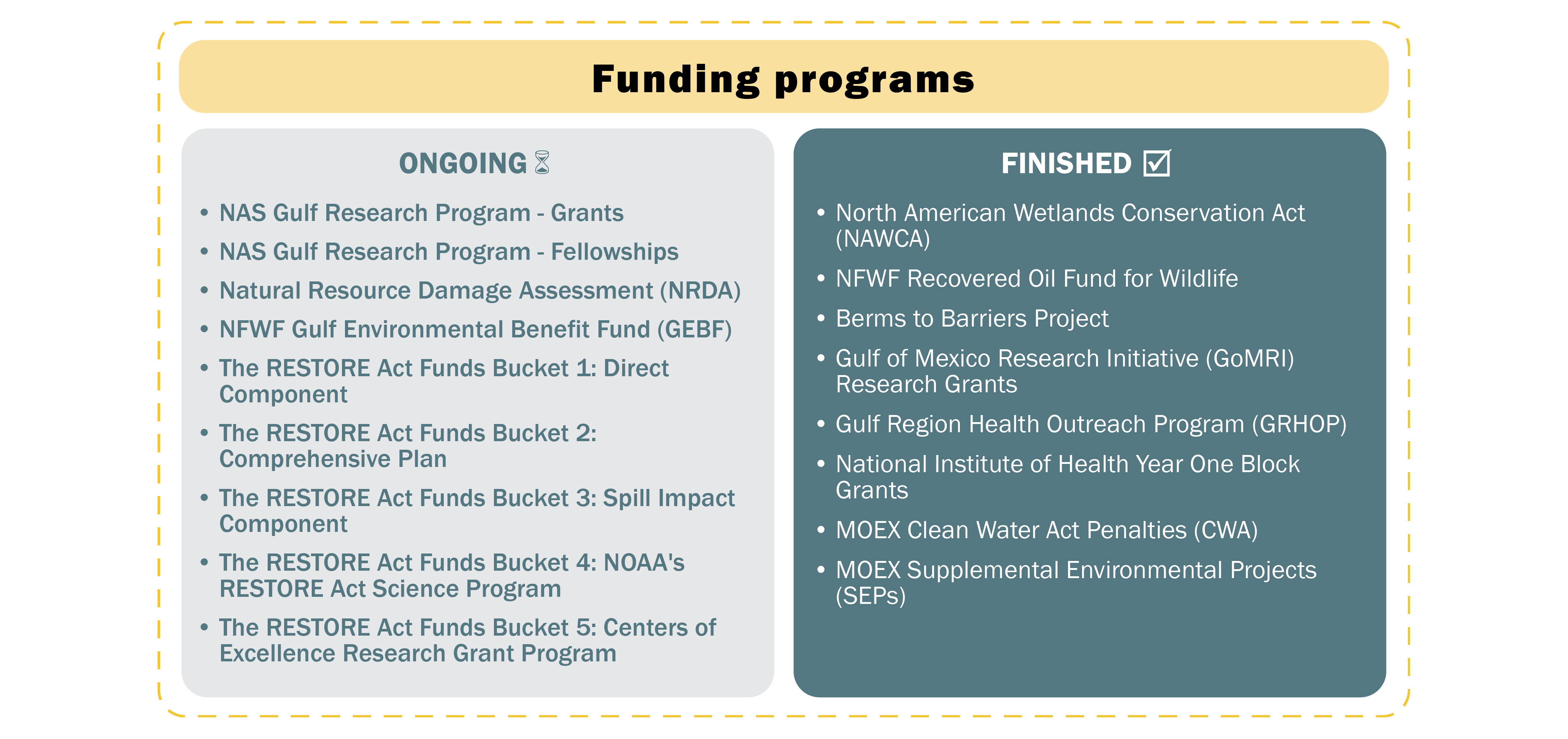
An introduction to the Deepwater Horizon Project Tracker
Learn how to track restoration, research, and recovery projects resulting from the 2010 Deepwater Horizon oil spill

So where are those billions of dollars going?
The funds have gone, in part, to research, recovery, and restoration projects along the Gulf of Mexico coast and beyond. These projects help us understand and repair the environmental and economic damage caused by the oil spill. Below is an example of a restoration project:


Island restoration before photo from Google Earth; after photo from Coastal Bend Bays & Estuaries Program (CBBEP). Click here for information about this project.
The funds reach those projects through the following funding programs:

(The RESTORE Act divides the funds into five priorities; these priorities are known as "buckets".)
Below is an example of how the funds flow from the responsible party (BP, Transocean, MOEX, Halliburton, or Anadarko) to funding programs, and then to specific projects.
Funding flow example: How funding got from the BP and Transocean criminal settlement to the Graveline Bay Marsh Restoration (Phase II) project in Alabama:
Click here to see more information on how much each funding program has received from the responsible parties. Note: The money flow for the example above may not be the same for other projects, particularly in other states.
Learn all about the Deepwater Horizon Project Tracker below.
The Deepwater Horizon Project Tracker
The goal of the Deepwater Horizon Project Tracker is to map and provide key information about all projects funded by Deepwater Horizon oil spill settlements, fines, and other payouts. The Project Tracker provides transparency to the public by clearly identifying funded project locations in the Gulf of Mexico and beyond.
The Project Tracker lets users search a list of all projects, launch a searchable map viewer, and download the project data—more on all that further below.
"Our community was severely impacted by the Deepwater Horizon disaster. The Deepwater Horizon Project Tracker is an invaluable tool for finding and sharing critical information on the numerous projects associated with the oil spill. Thank you so much for taking on and maintaining this complex task!" -Rich Colberg (Dauphin Island Town Council)
Where do the data in the Project Tracker come from?
There are over 1,600 projects (as of October 2022) included in the Project Tracker; for the latest project total see the Summaries page on the Project Tracker website.
How you can use the Project Tracker
Below is a list of the main components of the Tracker (among these components are various ways to access/explore the 1,500 projects; some of the components will be further explained below. Click on the ⓘ symbol to see the link for that page/component on the Project Tracker website; click on the link to be taken to that page/component.):
Let's walk through some of the above components and how you can use them:
And how can you follow the project funding using the tracker?
Once at the project's info page, scroll down to the bottom of the page and click the "+" symbol next to "View Raw Data" and explore all the funding info for that project:
Click here for definitions of the raw data list above.
In addition to general exploration of projects funded by Deepwater Horizon oil spill settlements, fines, and other payouts (using the Dashboard/Map Viewer or Projects list), here are other examples of how the Project Tracker is used:
- Who? Restoration councils. How do they use the Project Tracker? As a tool when reviewing grant applications to verify no duplication of effort (making sure projects are not already funded by another source and verifying projects will not duplicate research or restoration that is already ongoing in the Gulf).
- Who? Town councils or general public interested in conservation. How do they use the Project Tracker? The Project Tracker is the one place where you can easily find information on all projects and programs funded through the Deepwater Horizon settlements, across all restoration programs. It can also be used for finding nearby restoration or conservation work that has been funded by Deepwater Horizon oil spill settlements, fines, and other payouts.
- Who? Restoration advocates and/or writers. How do they use the Project Tracker? For finding summary information to tell stories (ex. summary information from the Tracker was used in a 10-year commemoration article in Shore and Beach).
Funding impact (featured projects)
All the projects funded by Deepwater Horizon oil spill settlements, fines, and other payouts have unique stories to tell. We present some of those stories below (via a subset of project types). Click on a project photo/title to zoom to it on the map. Click on "Equity" or "Acquisition/protection" above the map to see those types of featured projects. You will find out further below how to search the Project Tracker for climate change-related (or other types of) projects. Click on the yellow arrows to explore all of the projects listed for each project type.
Now that you've seen some featured projects, this is how you can search for more climate-related (or other types of) projects within the Project Tracker:
Now it's your turn
Now that you know what the Deepwater Horizon Project Tracker is and what it can do, visit it via the link below, then explore the other ways below to help enhance the environmental and economic health of the Gulf of Mexico.